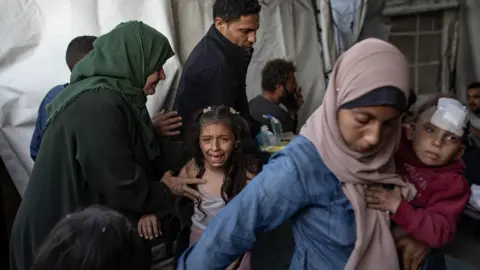 EPA
EPAAt least 27 Palestinians have been killed in an Israeli air strike on a school in northern Gaza that was serving as a shelter for displaced families, the Hamas-run health ministry says.
Dozens more were wounded when the Dar al-Arqam school in the north-eastern Tuffah district of Gaza City was hit, it cited a local hospital as saying.
The Israeli military said it struck “prominent terrorists who were in a Hamas command and control centre” in the city, without mentioning a school.
The health ministry earlier reported the killing of another 97 people in Israeli attacks over the previous 24 hours, as Israel said its ground offensive was expanding to seize large parts of the Palestinian territory.
The spokesman for Gaza’s Hamas-run Civil Defence agency, Mahmoud Bassal, said children and women were among the dead following the strike on Dar al-Arqam school.
He also said a woman who was heavily pregnant with twins was missing along with her husband, her sister, and her three children.
Video from the nearby al-Ahli hospital showed children being rushed there in cars and trucks with serious injuries.
A statement from the Israel Defense Forces (IDF) said the site in Gaza City that it struck had been used by Hamas fighters to plan attacks against Israeli civilians and troops.
It added that numerous steps had been taken to mitigate harm to civilians.
Overnight, at least 12 people were killed when several homes in Gaza City’s eastern Shejaiya district were struck, the Civil Defence said.
It posted a video that appeared to show the bodies of two young children being pulled by rescuers from the remains of a collapsed building.
A witness, who asked not to be named, told BBC Arabic’s Gaza Lifeline programme that he had been sleeping when he was “suddenly shaken by a violent explosion and discovered that it occurred at the house of our neighbours, the Ayyad family”.
There was no immediate comment from the IDF, but on Thursday morning it ordered residents of Shejaiya and four neighbouring areas to immediately evacuate to western Gaza City, warning that it was “operating with great force… to destroy the terrorist infrastructure”.
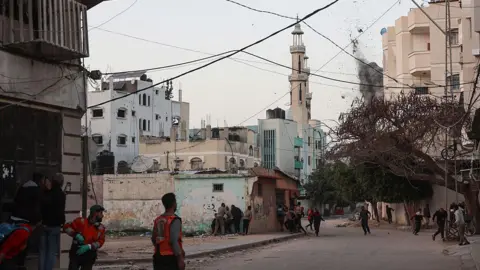 AFP
AFPThis week, the IDF issued similar evacuation orders for several areas of northern Gaza, as well as the entire southern city of Rafah and parts of neighbouring Khan Younis, prompting around 100,000 Palestinians to flee, according to the UN.
Israel renewed its aerial bombardment and ground offensive in Gaza on 18 March after the first phase of a ceasefire and hostage release deal agreed with Hamas in January came to an end and negotiations on a second phase of the deal stalled.
The IDF’s chief spokesperson, Brig-Gen Effie Defrin, told a briefing on Thursday that its operation had “progressed to another stage” in recent days.
“We have expanded operations in the southern Gaza Strip with the goal of encircling and dividing the Rafah area,” he said. “In northern Gaza, our troops are operating against terrorist targets, clearing the area, and dismantling terrorist infrastructure.”
He added that over the past two weeks Israeli forces had struck more than 600 “terrorist targets” across Gaza and “eliminated more than 250 terrorists”.
Before the strike in Tuffah, Gaza’s health ministry had said that at least 1,163 people had been killed over the same period. A UN agency has said they include more than 300 children.
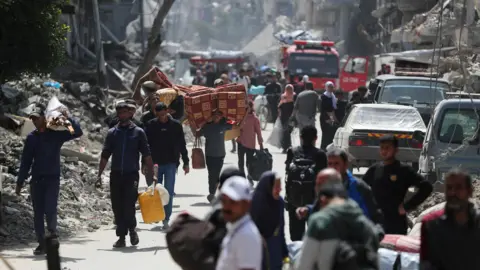 Reuters
ReutersOn Wednesday evening, Israeli Prime Minister Benjamin Netanyahu said Israeli forces were establishing another military corridor that would cut off Rafah from Khan Younis.
He argued that military pressure would force Hamas to release the remaining 59 hostages it is holding, up to 24 of whom are believed to be alive.
However, Hamas said it would not engage with Israel’s latest proposal for a new ceasefire, which is said to have been co-ordinated with the US, one of the mediators in the negotiations.
The Palestinian group said it accepted only the plan put forward by the two other mediators, Qatar and Egypt, for a 50-day truce.
The full details of that plan have not been disclosed, but it is understood the regional proposal would see five hostages being released in exchange for Palestinian prisoners, the withdrawal of Israeli forces from parts of Gaza where they have recently redeployed, and the influx of humanitarian aid. There would also be negotiations on ending the war.
Israel wants a larger number of hostages be released at the start of a new truce.
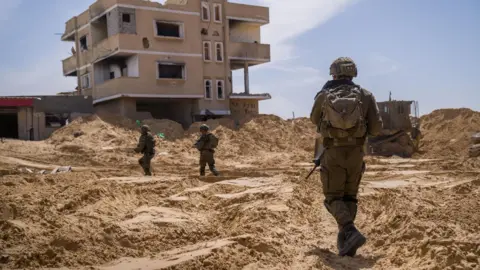 IDF via Reuters
IDF via ReutersIn another development on Thursday, the IDF said the general staff’s fact-finding mechanism was investigating the killing by Israeli forces of 15 Palestinian emergency workers near Rafah on 23 March, as well as their burial in what a UN official described as a “mass grave”.
“We want to have all the facts in a way that’s accurate and we can also hold accountable people if we need to,” an IDF spokesman said.
A Palestinian paramedic who survived the attack, speaking to the BBC, challenged the Israeli account of how five ambulances, a fire engine and a UN vehicle were fired on while responding to emergency calls.
The military said the vehicles were “advancing suspiciously” towards its troops without headlights or emergency signals. It also said a Hamas operative and “eight other terrorists” were among those killed, but named only one.
The survivor, Munther Abed, insisted that “all lights were on” until the vehicles came under direct fire. He also rejected the military’s claim that Hamas might have used the ambulances as cover, saying all the emergency workers were civilians.
The Israeli military launched a campaign to destroy Hamas in response to an unprecedented cross-border attack on 7 October 2023, in which about 1,200 people were killed and 251 were taken hostage.
More than 50,520 people have been killed in Gaza since then, according to the territory’s health ministry.
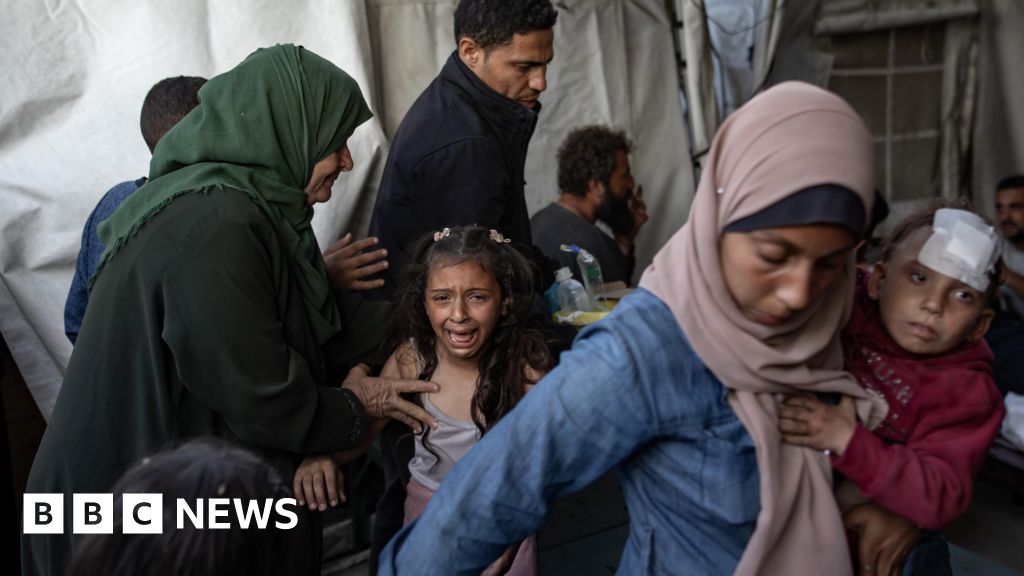

Leave a Reply